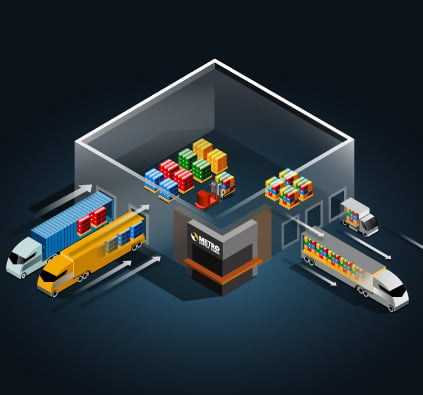Cross-docking has been a cornerstone of supply chain efficiency for decades. As global supply chains grow increasingly complex, the future of cross-docking is being reshaped by technology advancements, a heightened focus on sustainability, and shifting retailer and consumer demands. According to research from the Retail Leaders Industry Association, 90% of consumers expect two to three-day delivery as the norm and 30% expect same-day delivery.
What is cross-docking?
In today’s fast-moving supply chain world, every second counts, and that’s where cross-docking comes in. This logistics process bypasses traditional warehousing to deliver products more effectively. It moves goods from inbound to outbound transport with minimal delay, typically within 24 hours. Benefits include streamlined operations, quicker order fulfillment, reduced holding costs and a supply chain that meets increasing customer demands.
Is cross-docking right for your business?
Cross-docking boosts speed and efficiency across industries. For consumer packaged goods (CPG), food, beverage, or pharmaceuticals, it reduces dwell time and spoilage for short shelf-life products. In automotive, it supports just-in-time production with a steady flow of parts. Ecommerce and retail gain faster order fulfillment, efficient replenishment and lower warehousing costs.
The technology powering the future of cross-docking
Cross-docking demands advanced coordination among manufacturers, distributors, retailers, and consumers. Here we discuss the technological advancements and how Metro Supply Chain is leading the future of logistics.
1. Automation and robotics:
Automation significantly improves cross-docking efficiency by using advanced technology to enhance operations. Robotics handle unloading, sorting and reloading processes, which reduces manual work and can speed up processing.
- Conveyors equipped with tilt sorters: These move, scan and intelligently sort products into dedicated lanes.
- Automated guided vehicles (AGVs): Driverless robots move materials around a facility in a set path using sensors, lasers, magnets or radio waves. Sophisticated algorithms guide the AGVs to intelligently manage the inventory, compile order pallets and deliver them to collection points.
- Autonomous mobile robots (AMRs): AMRs adapt to their surroundings, making real-time navigation decisions to avoid obstacles and optimize routes. They efficiently move goods while requiring less space, and entire pallets can be received, stored and picked without unstacking. AMRs can be integrated with other warehouse technologies, such as conveyors and warehousing management software, to streamline the entire process.
Integrating these robotics into Metro Supply Chain’s facilities and warehouse management system improves our customers’ efficiency and scalability.
2. Smarter decision-making with AI and predictive analytics
According to a recent McKinsey survey, companies reported that the highest cost savings from AI are in supply chain management. AI is transforming cross-docking operations by enabling predictive analytics for demand forecasting and inventory management.
AI systems can analyze historical data, market trends and real-time conditions to anticipate incoming shipment volumes and adjust resources accordingly. By anticipating changes in demand and adjusting workflows, AI can:
- Minimize delays
- Reduce idle times
- Improve load consolidation
AI will continue to enhance shipment management in cross-docking facilities by synchronizing arrivals and departures, optimizing dock assignments and reducing vehicle wait times.
3. Internet of Things (IoT) integration and real-time insights
End-to-end transparency is essential for cross-docking. Metro Supply Chain’s IoT systems, like RFID and barcode scanning, enhance traceability and speed by providing detailed and fast insights into goods in transit. Real-time data exchange streamlines supply chain coordination and unlocks valuable business insights.
Our advanced technology handles bulk shipments and multi-part exceptions efficiently. Each parcel is scanned, labelled and processed effortlessly. These checkpoints can create shipping documents, generate ASNs (advanced shipping notices) and ensure goods reach their destinations on time and accurately.
IoT-integrated systems also enhance cross-docking operations by streamlining communication and coordination among supply chain participants. Our systems deliver real-time updates on the status of goods as they pass through the cross-docking facility, ensuring all parties are promptly informed of potential delays or issues. This seamless integration ensures all stakeholders have the information they need in the right place at the right time.
4. Smart transportation management
Our Transportation Management System (TMS) technology efficiently allocates outbound shipments to staging areas with clear route and destination labels, using advanced scanning and printing tools. It validates and organizes shipments into containers based on routes or zones, enhancing transport efficiency during cross-docking.
5. Sustainability in action
Optimized cross-docking improves fulfillment efficiency and benefits the environment. It helps reduce carbon footprints by cutting storage times and consolidating shipments, thereby lowering energy consumption and emissions. Metro Supply Chain’s electric trucks further enhance efficient cross-docking.
Partner with Metro Supply Chain for cross-docking solutions
Metro Supply Chain leverages advanced automation technology, real-time data exchange and AI-driven insights to transform cross-docking operations. Our solutions help our customers expedite fulfillment, enhance efficiency and gain seamless supply chain visibility.
Contact Metro Supply Chain to optimize your operations.
Related Posts
Archived Posts
- september 2024
- january 2024
- february 2024
- march 2024
- may 2024
